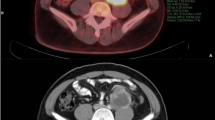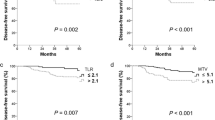Abstract
Purpose
Desmoid tumor (DT) is a rare monoclonal, fibroblastic proliferation characterized by a variable and often unpredictable clinical course. Initial active surveillance is recommended by current guideline, and surgery is one of the main therapies for DT. Predicting the prognosis and outcome of active surveillance for intra-abdominal DT is pressing issue.
Methods
The study included eighteen patients with intra-abdominal DT. Metabolic tumor volume (MTV), total lesion glycolysis (TLG), and maximum standardized uptake value (SUVmax) were measured. We analyzed their relationship with the outcome of active surveillance, as well as clinical, prognostic, and pathological data.
Results
The MTV and TLG of recurrent DT were significantly higher than those of non-recurrent DT (P < 0.001 and P = 0.00, respectively). The ROC curve suggested that the appropriate cutoff values for distinguishing recurrent DT from non-recurrent DT were 760.8 for MTV (sensitivity = 1, specificity = 0.857 and AUC = 0.929), and 1318.4 for TLG (sensitivity = 1, specificity = 0.786, and AUC = 0.911). The cutoff values of MTV and TLG significantly correlated with PFS using the Kaplan–Meier method (P = 0.002 and P = 0.007, respectively). MTV and TLG could distinguish DTs with subsequent progression from stable ones (P = 0.004 and P = 0.004, respectively). The ROC curve suggested that the appropriate cutoff values for distinguishing DTs with subsequent progression from stable ones were 197.1 for MTV (sensitivity = 0.9, specificity = 1, and AUC = 0.900), and 445.45 for TLG (sensitivity = 0.9, specificity = 1, and AUC = 0.900).
Conclusion
Volume-based 18F-FDG-PET can predict prognosis of intra-abdominal DT. MTV and TLG can predict the outcome of active surveillance for intra-abdominal DT. MTV and TLG can potentially be predictors of surgical risk and difficulty.


Similar content being viewed by others
References
Desmoid Tumor Working G: The management of desmoid tumours: A joint global consensus-based guideline approach for adult and paediatric patients. Eur J Cancer 2020, 127:96–107.
Penel N, Le Cesne A, Bonvalot S, Giraud A, Bompas E, Rios M, Salas S, Isambert N, Boudou-Rouquette P, Honore C et al: Surgical versus non-surgical approach in primary desmoid-type fibromatosis patients: A nationwide prospective cohort from the French Sarcoma Group. Eur J Cancer 2017, 83:125-131.
Salas S, Dufresne A, Bui B, Blay JY, Terrier P, Ranchere-Vince D, Bonvalot S, Stoeckle E, Guillou L, Le Cesne A et al: Prognostic factors influencing progression-free survival determined from a series of sporadic desmoid tumors: a wait-and-see policy according to tumor presentation. J Clin Oncol 2011, 29(26):3553-3558.
Bhandari S, Taylor NJ, Sinha A, Sonoda L, Sanghera B, Wong WL, Goh V, Clark SK: Can combined 18F-FDG-PET and dynamic contrast-enhanced MRI predict behavior of desmoid tumors in patients with familial adenomatous polyposis? Diseases of the Colon & Rectum 2012, 55(10):1032-1037.
Byun BH, Kong CB, Park J, Seo Y, Lim I, Choi CW, Cho WH, Jeon DG, Koh JS, Lee SY et al: Initial metabolic tumor volume measured by 18F-FDG PET/CT can predict the outcome of osteosarcoma of the extremities. J Nucl Med 2013, 54(10):1725-1732.
Andersen KF, Fuglo HM, Rasmussen SH, Petersen MM, Loft A: Volume-Based F-18 FDG PET/CT Imaging Markers Provide Supplemental Prognostic Information to Histologic Grading in Patients With High-Grade Bone or Soft Tissue Sarcoma. Medicine 2015, 94(51).
Choi E-S, Ha S-G, Kim H-S, Ha JH, Paeng JC, Han I: Total lesion glycolysis by 18F-FDG PET/CT is a reliable predictor of prognosis in soft-tissue sarcoma. European Journal of Nuclear Medicine and Molecular Imaging 2013, 40(12):1836-1842.
Li YJ, Dai YL, Cheng YS, Zhang WB, Tu CQ: Positron emission tomography (18)F-fluorodeoxyglucose uptake and prognosis in patients with bone and soft tissue sarcoma: A meta-analysis. European Journal of Surgical Oncology (EJSO) 2016, 42(8):1103-1114.
Costa J, Wesley RA, Glatstein E, Rosenberg SA: The grading of soft tissue sarcomas results of a clinicohistopathologic correlation in a series of 163 cases. Cancer 1984, 53(3):530-541.
Liu DN, Li ZW, Wang HY, Zhao M, Zhao W, Hao CY: Use of 18F-FDG-PET/CT for Retroperitoneal/Intra-Abdominal Soft Tissue Sarcomas. Contrast Media Mol Imaging 2018, 2018:2601281.
Funding
This study was supported by Science Foundation of Peking University Cancer Hospital (XKFZ2421), National Natural Science Foundation of China 91959120, Capital Health Research and Development of Special Funds (approval No. 2020-1-1021), Science Foundation of Peking University Cancer Hospital (approval No. 2021-15), Beijing Municipal Administration of Hospital’s Ascent Plan (approval No. DFL20181104).
Author information
Authors and Affiliations
Corresponding author
Ethics declarations
Conflict of interest
We declare that there are no other financial or non-financial interests that are directly or indirectly related to the work submitted for publication.
Additional information
Publisher's Note
Springer Nature remains neutral with regard to jurisdictional claims in published maps and institutional affiliations.
Rights and permissions
Springer Nature or its licensor (e.g. a society or other partner) holds exclusive rights to this article under a publishing agreement with the author(s) or other rightsholder(s); author self-archiving of the accepted manuscript version of this article is solely governed by the terms of such publishing agreement and applicable law.
About this article
Cite this article
Liu, DN., Li, CP., Li, HW. et al. Volume-based 18F-FDG PET/CT predicts prognosis and outcome of active surveillance for intra-abdominal desmoid tumor. Abdom Radiol 49, 958–963 (2024). https://doi.org/10.1007/s00261-023-04145-z
Received:
Revised:
Accepted:
Published:
Issue Date:
DOI: https://doi.org/10.1007/s00261-023-04145-z




